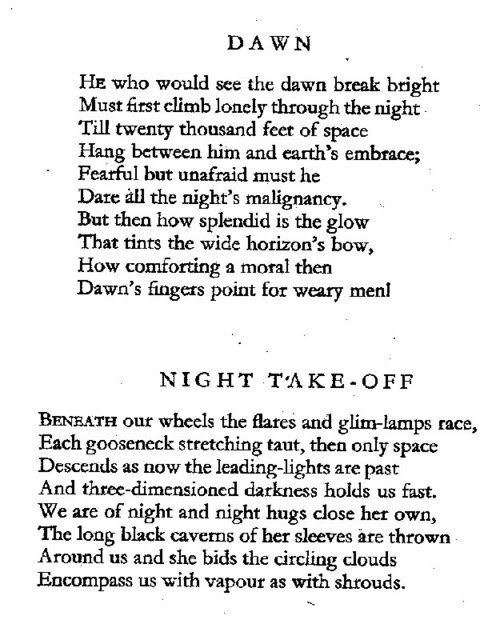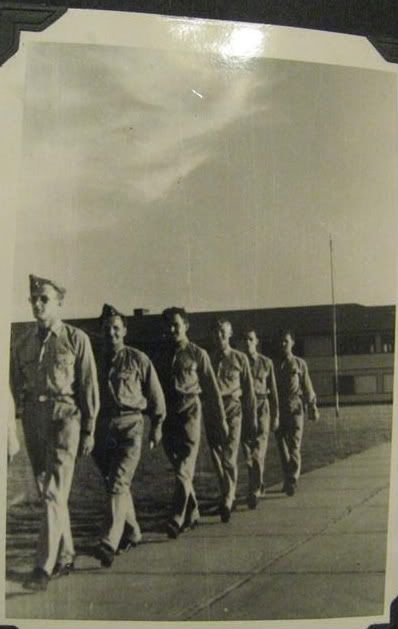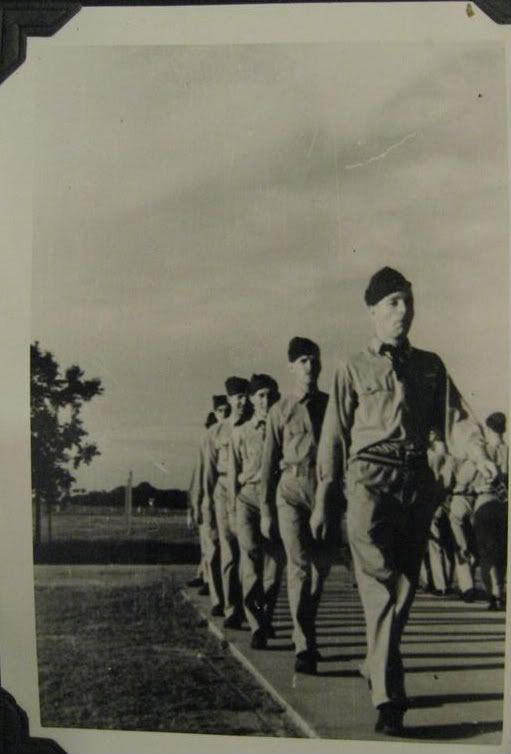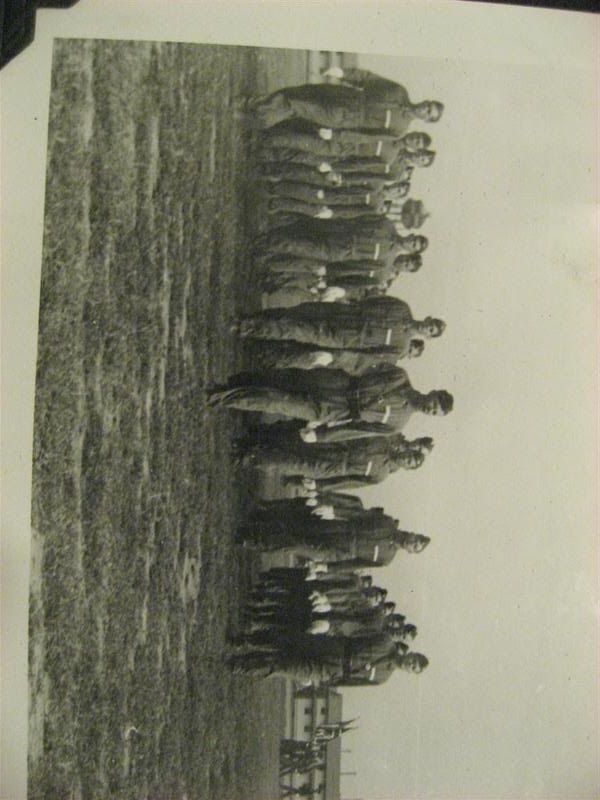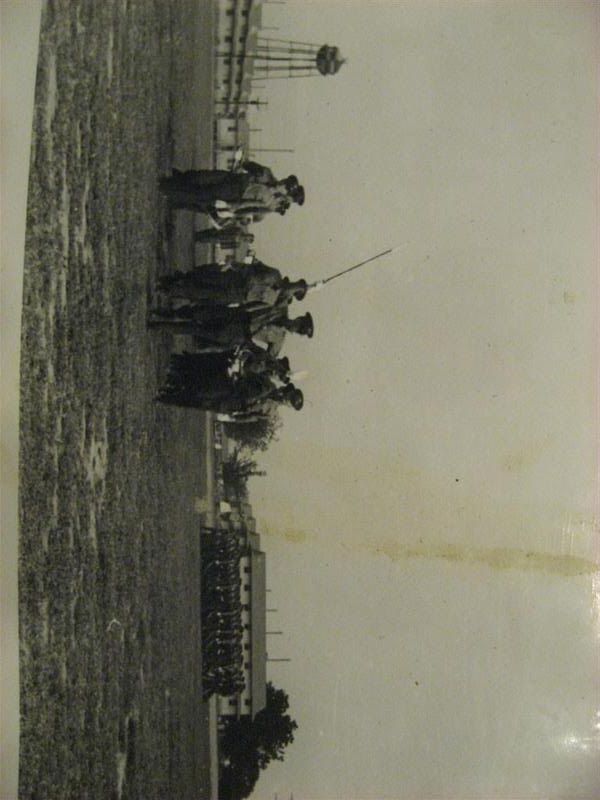Gaining An R.A.F Pilots Brevet In WW II
Thread Starter
Join Date: Mar 2008
Location: LIVERPOOL
Posts: 401
Likes: 0
Received 0 Likes
on
0 Posts
I have managed to increase the size of this poem by specifying max size in scanner, picasa, photo bucket, and then correct size in pprune. Fingers crossed


Thread Starter
Join Date: Mar 2008
Location: LIVERPOOL
Posts: 401
Likes: 0
Received 0 Likes
on
0 Posts
I have just found this photograph of the airman's quarters at R.A.F Moncton. It shows typical accommodation during the war. At the top of the bed will be seen the "bed pack" which had to be made up neatly each morning, ready for inspection. and not removed until just before lights out. In the U.K single iron beds were used and not bunk beds. White sheets were only standard issue for aircrew, and officers.


Join Date: Sep 2008
Location: Bournemouth
Age: 76
Posts: 119
Likes: 0
Received 0 Likes
on
0 Posts
What Star rating?
Cliff, pretty good looking accommodation?
I wouldn't want to stay in one of those beds for a 2 week holiday though!
Reg called me from Belgium this morning to announce that he's been given the OK and going to spend the weekend with his relatives before returning home next week. Thought you would like to know.
Regards Andy
I wouldn't want to stay in one of those beds for a 2 week holiday though!
Reg called me from Belgium this morning to announce that he's been given the OK and going to spend the weekend with his relatives before returning home next week. Thought you would like to know.
Regards Andy
Join Date: Jun 2001
Location: due south
Posts: 1,332
Likes: 0
Received 0 Likes
on
0 Posts
cliffnemo: Have you seen this poem before ? it is in the book "Lie in the Dark and Listen" by Wing Commander Ken Rees with Karen Arrandale.
"Lie in the Dark and Listen."
Lie in the dark and listen,
It's clear tonight so they're flying high,
Hundreds of them, thousands perhaps,
Riding the icy, moonlight sky,
Men, materials, bombs and maps,
Altimeters and guns and charts,
Coffee, sandwiches, fleece-lined boots
Bones and muscles and minds and hearts
English saplings with English roots
Deep in the earth they've left below,
Lie in the dark and let them go
Lie in the dark and listen.
Lie in the dark and listen
They're going over in waves and waves
High above villages, hills and streams
Country churches and little graves
And little citizens' worried dreams.
Very soon they'll have reached the sea
And far below them will lie the bays
And coves and sands where they used to be
Taken for summer holidays.
Lie in the dark and let them go
Lie in the dark and listen.
Lie in the dark and listen.
City magnates and steel contractors.
Factory workers and politicians
Soft hysterical little actors
Ballet dancers, "Reserved" musicians,
Safe in your warm civilian beds.
Count your profits and count your sheep
Life is flying above your heads
Just turn over and try to sleep.
Lie in the dark and let them go
Theirs is a debt you'll forever owe
Lie in the dark and listen.
Noel Coward
"Lie in the Dark and Listen."
Lie in the dark and listen,
It's clear tonight so they're flying high,
Hundreds of them, thousands perhaps,
Riding the icy, moonlight sky,
Men, materials, bombs and maps,
Altimeters and guns and charts,
Coffee, sandwiches, fleece-lined boots
Bones and muscles and minds and hearts
English saplings with English roots
Deep in the earth they've left below,
Lie in the dark and let them go
Lie in the dark and listen.
Lie in the dark and listen
They're going over in waves and waves
High above villages, hills and streams
Country churches and little graves
And little citizens' worried dreams.
Very soon they'll have reached the sea
And far below them will lie the bays
And coves and sands where they used to be
Taken for summer holidays.
Lie in the dark and let them go
Lie in the dark and listen.
Lie in the dark and listen.
City magnates and steel contractors.
Factory workers and politicians
Soft hysterical little actors
Ballet dancers, "Reserved" musicians,
Safe in your warm civilian beds.
Count your profits and count your sheep
Life is flying above your heads
Just turn over and try to sleep.
Lie in the dark and let them go
Theirs is a debt you'll forever owe
Lie in the dark and listen.
Noel Coward
Thread Starter
Join Date: Mar 2008
Location: LIVERPOOL
Posts: 401
Likes: 0
Received 0 Likes
on
0 Posts
Words , Words, Words.
henrycrun
HENRY, No I haven’t read it before. What can I say ? Very descriptive, excellent, emotive, nostalgic ? There are probably a few old codgers reading that poem who were affected like me with mind wandering at the end of each line of the poem. To be facetious , as usual. The line commencing Coffee reminded me of “ "Instructions to Lancaster crews, action to be taken when hydraulic oil is lost. - The crew will empty the contents of their flasks into the header tank, then urinate into the flasks , and pour into header tank” Never did find out why the F.E couldn’t load a spare can of hydraulic oil.
Churches, bays coves , and sands.? Hemswell,- Lincoln Cathedral.- Skegness ?
And oft when on my couch I lie, in vacant or in pensive mood, they flash upon that inward eye, which is the bliss of solitude.
Blimey , I am now thinking about Wordsworth, and Grasmere, then playing round the top of Helvelyn in a tiger moth. I had better get down to earth, and compose my next effort.
HENRY, No I haven’t read it before. What can I say ? Very descriptive, excellent, emotive, nostalgic ? There are probably a few old codgers reading that poem who were affected like me with mind wandering at the end of each line of the poem. To be facetious , as usual. The line commencing Coffee reminded me of “ "Instructions to Lancaster crews, action to be taken when hydraulic oil is lost. - The crew will empty the contents of their flasks into the header tank, then urinate into the flasks , and pour into header tank” Never did find out why the F.E couldn’t load a spare can of hydraulic oil.
Churches, bays coves , and sands.? Hemswell,- Lincoln Cathedral.- Skegness ?
And oft when on my couch I lie, in vacant or in pensive mood, they flash upon that inward eye, which is the bliss of solitude.
Blimey , I am now thinking about Wordsworth, and Grasmere, then playing round the top of Helvelyn in a tiger moth. I had better get down to earth, and compose my next effort.
Guest
Posts: n/a
Back in the fold...
It is good to be back and thank you all for your good wishes, especially my good friend, Andy, for keeping you "au courant". So where were we...
After two wonderful weeks in Toronto we entrained for the two day journey to Albany, Georgia. Reluctantly we discarded our RAF uniforms and it was back to the grey suits and the pith helmets ( only we didn't quite pronounce it like it was written).
Albany was a very small Southern town and, in 1942, still very much part of the Confederate States who had seceded from the Union. We quickly learned that anyone from the Northern States was still referred to as "Damyankee" and that was all one word. The accent was quite different from any that we had previously encountered and completely charmed us. We had the luxury of a communal lounge/mess and the phone would ring , one of us would answer and it would often be a girl's voice ..."Are y'all a British boooy ? Would y'all just tolk ?" They would not believe us when we told them that it was they who had the accent, not us.
We learned how to fly and we learned the hard way. General Arnold, when he proposed the scheme that bears his name, had made it quite clear that we would follow the very tough itinerary prescribed for the U.S. Army Air Corps, as the U.S. Air Force was then known, and that standards would, in no way, be relaxed despite the crying need for pilots in the U.K. We got the full peacetime training comprising two hundred hours on three different types of aircraft at a time when some unlucky people were going straight on to Hurricanes and Spitfires with some twenty hours on Tiger Moths in their log books! I have forgotten the times that I have said that I am still here today because of that training (and a lot... I mean a LOT of luck) and I am eternally grateful for it.
Of the five hundred, or so, cadets who started training in the Southeast Training Center (as it was called and spelled),only one hundred and twenty of the class of 42A (The US College system i;e the first class to graduate in 1942) were awarded the coveted silver wings. Many of those who were "washed out" , sometimes for the most trivial "disciplinary reasons" were sent up to Canada where, often, their training was continued or changed to another category i;e Bomb Aimer, Navigator etc. and were flying operationally in England long before we returned.
The school, Darr Aero Tech., was run by civilian Instructors, Flying and Ground School. There were two or three US Army Officers as Check Pilots and one US Army,very West Point Officer responsible for the whole unit. Discipline was maintained by the Class ahead of us 41F. They were all Americans and were used to the West Point "Honour System" which consisted or reporting anyone who committed one of the many misdemeanours possible to the 41F Discipline committee. This included reporting yourself. There was a trio of the Class of 41F who used to go to the lounge after hours to practice "Barbershop" singing and then report themselved to the Committee !
We, as the first class of British "Caydets" had this Class of 41F over us to administer the discipline and the "hazing" that is part and parcel of American College life. At meals an Upperclassman would tell the unfortunate Lowerclassman (us!) "Take a square meal, Mister" and the poor underdog would have to bring the food to his mouth and insert it at right angles throughout the
meal while sitting on the obligatory front six inches of his chair which is all that we were allowed to use whilst we were Lowerclassmen. Room inspection , always carried out by the Uppers (I will use this in future to save my finger, n.b. singular !) . This involved the running of white silk gloves over cupboards, beds and floor..the lot. One speck of dust and a "gig" (demerit) would result. A nickel (5c) would be thrown on your stretched out blanket and it had to "ripple". The turnover of the sheet had to measure exactly six and a half inches and this was measured carefully. So many gigs and our only free time away from the camp (We were not allowed off the Camp except Saturday from noon until Sunday at 1800 hrs.) was curtailed by hours of marching in full uniform (Hastily supplied ny the U.S after one look at us all paraded in our grey flannel suits). As the temperature was always around thirty degrees C with 110% humidity,you can imagine the spirit of unrest that was running through the entire course, especially amongst the several "remustered" Sergeants and Corporals, some of them hardbitten veterans of the bombing of Biggin Hill and other targets of the Blitz. Some of their replies to the Upper were "Get stuffed" "Belt up" and those are the printable ones. Those who survived, and many did not, did not see much of Albany during the six weeks of being the Lowerclass. The "Special Relationship" wore a bit thin at times and the R.A.F liaison Officer, Flt/Lt. Hill, who visited us frequently had his work cut out to persuade us to grin and bear it for the sake of Britain's desperate need. There was a patriotic song at that time. It started off "Off we go, into the wild blue yonder.. "and finished "Nothing will stop the Army Air Corps." Whereupon the whole of us "Lowers" would come in en masse "Except the weather" with the "Except" being long drawn out. There was sometimes quite a lot of blood spilt after such an evening with the Uppers.
After two wonderful weeks in Toronto we entrained for the two day journey to Albany, Georgia. Reluctantly we discarded our RAF uniforms and it was back to the grey suits and the pith helmets ( only we didn't quite pronounce it like it was written).
Albany was a very small Southern town and, in 1942, still very much part of the Confederate States who had seceded from the Union. We quickly learned that anyone from the Northern States was still referred to as "Damyankee" and that was all one word. The accent was quite different from any that we had previously encountered and completely charmed us. We had the luxury of a communal lounge/mess and the phone would ring , one of us would answer and it would often be a girl's voice ..."Are y'all a British boooy ? Would y'all just tolk ?" They would not believe us when we told them that it was they who had the accent, not us.
We learned how to fly and we learned the hard way. General Arnold, when he proposed the scheme that bears his name, had made it quite clear that we would follow the very tough itinerary prescribed for the U.S. Army Air Corps, as the U.S. Air Force was then known, and that standards would, in no way, be relaxed despite the crying need for pilots in the U.K. We got the full peacetime training comprising two hundred hours on three different types of aircraft at a time when some unlucky people were going straight on to Hurricanes and Spitfires with some twenty hours on Tiger Moths in their log books! I have forgotten the times that I have said that I am still here today because of that training (and a lot... I mean a LOT of luck) and I am eternally grateful for it.
Of the five hundred, or so, cadets who started training in the Southeast Training Center (as it was called and spelled),only one hundred and twenty of the class of 42A (The US College system i;e the first class to graduate in 1942) were awarded the coveted silver wings. Many of those who were "washed out" , sometimes for the most trivial "disciplinary reasons" were sent up to Canada where, often, their training was continued or changed to another category i;e Bomb Aimer, Navigator etc. and were flying operationally in England long before we returned.
The school, Darr Aero Tech., was run by civilian Instructors, Flying and Ground School. There were two or three US Army Officers as Check Pilots and one US Army,very West Point Officer responsible for the whole unit. Discipline was maintained by the Class ahead of us 41F. They were all Americans and were used to the West Point "Honour System" which consisted or reporting anyone who committed one of the many misdemeanours possible to the 41F Discipline committee. This included reporting yourself. There was a trio of the Class of 41F who used to go to the lounge after hours to practice "Barbershop" singing and then report themselved to the Committee !
We, as the first class of British "Caydets" had this Class of 41F over us to administer the discipline and the "hazing" that is part and parcel of American College life. At meals an Upperclassman would tell the unfortunate Lowerclassman (us!) "Take a square meal, Mister" and the poor underdog would have to bring the food to his mouth and insert it at right angles throughout the
meal while sitting on the obligatory front six inches of his chair which is all that we were allowed to use whilst we were Lowerclassmen. Room inspection , always carried out by the Uppers (I will use this in future to save my finger, n.b. singular !) . This involved the running of white silk gloves over cupboards, beds and floor..the lot. One speck of dust and a "gig" (demerit) would result. A nickel (5c) would be thrown on your stretched out blanket and it had to "ripple". The turnover of the sheet had to measure exactly six and a half inches and this was measured carefully. So many gigs and our only free time away from the camp (We were not allowed off the Camp except Saturday from noon until Sunday at 1800 hrs.) was curtailed by hours of marching in full uniform (Hastily supplied ny the U.S after one look at us all paraded in our grey flannel suits). As the temperature was always around thirty degrees C with 110% humidity,you can imagine the spirit of unrest that was running through the entire course, especially amongst the several "remustered" Sergeants and Corporals, some of them hardbitten veterans of the bombing of Biggin Hill and other targets of the Blitz. Some of their replies to the Upper were "Get stuffed" "Belt up" and those are the printable ones. Those who survived, and many did not, did not see much of Albany during the six weeks of being the Lowerclass. The "Special Relationship" wore a bit thin at times and the R.A.F liaison Officer, Flt/Lt. Hill, who visited us frequently had his work cut out to persuade us to grin and bear it for the sake of Britain's desperate need. There was a patriotic song at that time. It started off "Off we go, into the wild blue yonder.. "and finished "Nothing will stop the Army Air Corps." Whereupon the whole of us "Lowers" would come in en masse "Except the weather" with the "Except" being long drawn out. There was sometimes quite a lot of blood spilt after such an evening with the Uppers.
Guest
Posts: n/a
First picture. The second inline
I am pretty sure that the man, second in line in the first picture of the unfortunate Brirish Cadets "walking" their "gigs" , at the weekend instead of being allowed off camp, is the husband of the girl who was the model for the famous "Jane" of "the Daily Mirror". His initials L-P (Double barreled name). He was a very nice chap who would never talk about Jane. The last picture was of the notorious Upperclass men American 41F marching at Cochran Field, Macon, GA. The other marchers were the first of the British 42A .Look for the Union Jack right background. Regle
Join Date: Mar 2008
Location: Netherlands
Posts: 7
Likes: 0
Received 0 Likes
on
0 Posts
I would like to thank you all for doing the effort of typing all your stories and posting them here on the board. I really enjoy reading them and i hope you will keep posting them.
It is also very nice to read that in WO II Moncton was a place where you trained, the airfield has a very large history. It is especially nice that people are still getting trained there. I just got back from 2 months of flying lessons in moncton. I guess the airfield changed a lot since then but still.
Can someone maybe explain how there solo went in those days. Today, i think all the planes are quiet strong and will not collapse that easy especially when someone going for his first solo has a very hard "positive" touchdown. Did many accidents happen in those days?
Thanks for all your stories!!
It is also very nice to read that in WO II Moncton was a place where you trained, the airfield has a very large history. It is especially nice that people are still getting trained there. I just got back from 2 months of flying lessons in moncton. I guess the airfield changed a lot since then but still.
Can someone maybe explain how there solo went in those days. Today, i think all the planes are quiet strong and will not collapse that easy especially when someone going for his first solo has a very hard "positive" touchdown. Did many accidents happen in those days?
Thanks for all your stories!!
Last edited by justifier; 1st Oct 2008 at 20:38.
Join Date: Sep 2008
Location: Bournemouth
Age: 76
Posts: 119
Likes: 0
Received 0 Likes
on
0 Posts
Moncton
OK I'm only a young whippa snatcher but I believe that Moncton was only a temporary halt or collecting camp on the way to Toronto, which was a distribution centre. I don't think there was any flying there for the RAF. In fact I remember reading somewhere that Moncton was not open in time for the first batch of cadets, is that right Reg? It probably would have been open for Reg on the way home?
Also the pupils would have soloed (or not) in a Boeing Stearman, I have spoken to many pilots from the USA courses and I have never heard a criticism of one of these aircraft yet. They are built like British S*** Houses! And I am sure that they could and would take serious abuse, even in those days, any cadet comments on this?
Here I am on a Red Letter Day in Old Buck, does it look fragile to anyone?
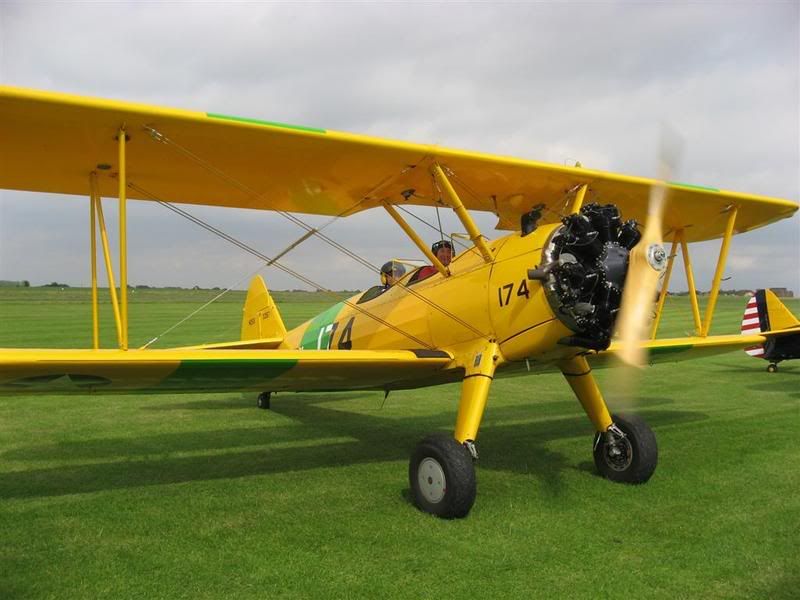
Stearmans in Darr Aero Albany GA ( Photo by Reg)
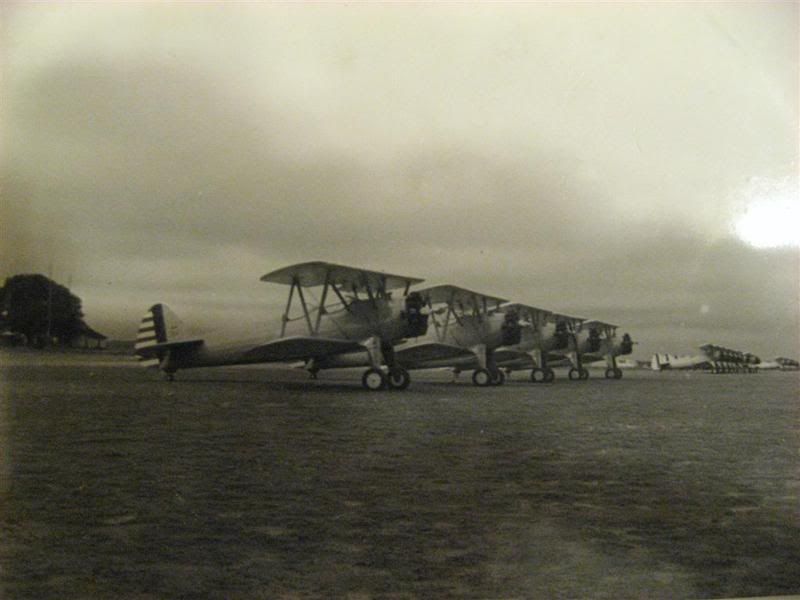
Also the pupils would have soloed (or not) in a Boeing Stearman, I have spoken to many pilots from the USA courses and I have never heard a criticism of one of these aircraft yet. They are built like British S*** Houses! And I am sure that they could and would take serious abuse, even in those days, any cadet comments on this?
Here I am on a Red Letter Day in Old Buck, does it look fragile to anyone?

Stearmans in Darr Aero Albany GA ( Photo by Reg)

Guest
Posts: n/a
Ten out of ten ,Andy.
You are absolutely correct, Andy. Moncton was not ready when I landed in Canada on the 30th. May 1941. The" Britannic " landed in Halifax, Nova Scotia. Halifax, incidentally , was the scene of one of the worst incidents of the first World War. In April 1917 a vessel, carrying explosives, was rammed in the harbour. It blew up and killed 1,800 people, injured 20,000 others and completely destroyed the northern part of the city.
Moncton was not yet in use so we were sent to the main "Manning Pool" at Toronto. On our return to the U.K. after completing our training we left the U.S.A. on a train journey ,that took us five days, to the receiving centre at Moncton. New Brunswick. There was no R.A.F Air field there, to my knowledge. I do not remember the exact date that we sailed (From Moncton actually) but the voyage took 10 days on an old Nederlands tramp steamer that had been torpedoed already , cut in half and stuck together with a new bow or stern. I do not know which. The S.S. Vollendam, as she was named, was escorted by two destroyers and two days out ,we were up on deck ,and one of the destroyers blew up and sank in minutes with no survivors, that we could see. We continued and reached Greenock early Feb. 1942.
In reply to our very welcome Nederlands friend (Take a tip. People from Holland do not like the adjective "Dutch" for obvious reasons). Holland, Netherlands or Nederlands is much better) Is that true "Justifier"?
The Stearman was and is one of the sturdiest aircraft ever made although I would'nt agree to Andy's likeness to a British latrine. It had to be when you think of the millions of heavy landings, most of which were more reasonably classed as "arrivals" that the aircraft made during it's long career. I read your letter with interest, Justifier. I know Holland quite well and used to play cricket there and,at Rotterdam, saw Holland beat a very good Australian team that included most of their Internationals, one of which was a very fast bowler, Neil Hawke. I was very badly shot up when attacking the German Fighter base at Leeuwarden just off the Friesian Islands in 1942. I was flying a Mosquito of the very first Mosquito Squadron 105 ,daylight, unarmed bomber version of 2 Group
Bomber Command. carrying 4x 500lb. bombs with a 9 sec. delay to enable us to get away before the bombs exploded. I was plastered by the light flak,the complete front of the nose was shot away, my port engine set on fire, my instrument panel disappeared, I was wounded in my left thigh (although I did'nt feel a thing until later on, and my Observer,Les Hogan, was hit, but not badly ,in the chest. We got the fire out and managed to get out over the North Sea... All this at about 100 feet. My feet were sticking out in the slipstream and I did'nt have flying boots on ,only ordinary boots. I will tell you the whole story ,later on,.... of how we got back only for the other engine to give out over Marham, our base in Norfolk . I'll give you a clue. We both survived ! Tot Siens ,Justifier or is it Tot Straaks ? Regle
Moncton was not yet in use so we were sent to the main "Manning Pool" at Toronto. On our return to the U.K. after completing our training we left the U.S.A. on a train journey ,that took us five days, to the receiving centre at Moncton. New Brunswick. There was no R.A.F Air field there, to my knowledge. I do not remember the exact date that we sailed (From Moncton actually) but the voyage took 10 days on an old Nederlands tramp steamer that had been torpedoed already , cut in half and stuck together with a new bow or stern. I do not know which. The S.S. Vollendam, as she was named, was escorted by two destroyers and two days out ,we were up on deck ,and one of the destroyers blew up and sank in minutes with no survivors, that we could see. We continued and reached Greenock early Feb. 1942.
In reply to our very welcome Nederlands friend (Take a tip. People from Holland do not like the adjective "Dutch" for obvious reasons). Holland, Netherlands or Nederlands is much better) Is that true "Justifier"?
The Stearman was and is one of the sturdiest aircraft ever made although I would'nt agree to Andy's likeness to a British latrine. It had to be when you think of the millions of heavy landings, most of which were more reasonably classed as "arrivals" that the aircraft made during it's long career. I read your letter with interest, Justifier. I know Holland quite well and used to play cricket there and,at Rotterdam, saw Holland beat a very good Australian team that included most of their Internationals, one of which was a very fast bowler, Neil Hawke. I was very badly shot up when attacking the German Fighter base at Leeuwarden just off the Friesian Islands in 1942. I was flying a Mosquito of the very first Mosquito Squadron 105 ,daylight, unarmed bomber version of 2 Group
Bomber Command. carrying 4x 500lb. bombs with a 9 sec. delay to enable us to get away before the bombs exploded. I was plastered by the light flak,the complete front of the nose was shot away, my port engine set on fire, my instrument panel disappeared, I was wounded in my left thigh (although I did'nt feel a thing until later on, and my Observer,Les Hogan, was hit, but not badly ,in the chest. We got the fire out and managed to get out over the North Sea... All this at about 100 feet. My feet were sticking out in the slipstream and I did'nt have flying boots on ,only ordinary boots. I will tell you the whole story ,later on,.... of how we got back only for the other engine to give out over Marham, our base in Norfolk . I'll give you a clue. We both survived ! Tot Siens ,Justifier or is it Tot Straaks ? Regle
Thread Starter
Join Date: Mar 2008
Location: LIVERPOOL
Posts: 401
Likes: 0
Received 0 Likes
on
0 Posts
Cliffnemo To Fareast Slave Diver Wilco.
JUSTIFIER . As far as we were concerned Moncton was just a transit camp, and I cannot remember an airfield. A pic of one of the buildings taken on our return journey is above. On my first solo, I was very apprehensive waiting for the test, but on pushing the throttle wide open , immediately became confident, almost exuberant. I later realized this was due to not having a critic strapped in to the front cockpit.
I found the Tiger Moth and the P.T17 ( A.K.A Boeing Stearman) sturdy enough to stand fairly rough handling, but bear in mind we carried out three point landings, rather than wheel them in., so most times they stalled out and sank gently onto the ground. I saw many “arrivals” but no bent undercarts.

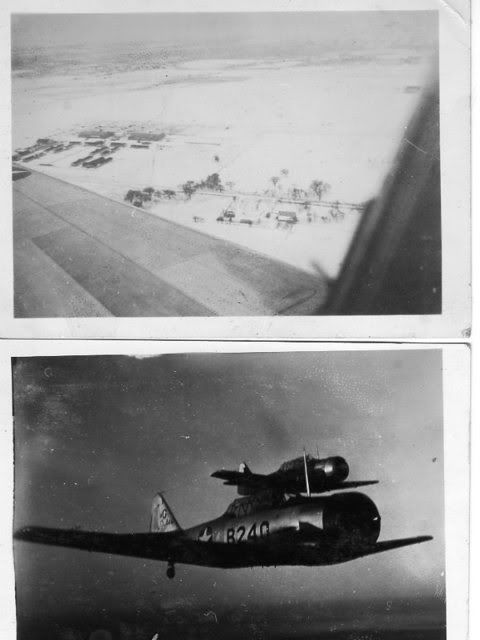
About December we had snow, pic below, but this did not affect our training, as we did not experience wing icing, possibly due to low humidity, and the fact that we didn’t need to fly too high to perform our exercises. We could also apply carburettor heating, and so prevent carburettor icing. The American version of the Irvin jacket together with our four thickness white silk inner gloves and leather gauntlets kept us warm. The enclosed cockpit of the A.T.6 made a big difference to our comfort , particularly when side slipping. The billets and crew room were very warm as the gas for the central heating came from local oil fields at very low cost. In fact it was just taken for granted, and when the billets became to warm, cadets regulated the heat by opening the windows.
Flying exercises continued, all as before plus air to air two plane gunnery practice, air to ground gunnery , all good fun. Formation flying check ride with a Mr Schellennerger. ,. Two 2 ˝ hour trips navigational course flying. Precautionary landings , whatever they may be. Solo night flying navigation exercises.
On the Link trainer we had instruction on Standard Beam Approach , and Descent through Cloud procedure. Later log book was stamped Advanced Syllabus Exam passed..
Classroom lessons included lectures on reconnaissance , on conducting a square search (This consists of flying to the point where it is estimated a plane is down in the drink, and then flying N.S.E and W in ever increasing squares until found. ).and navigation, rhumb lines .great circles, phew.
On a lighter note, one of the cadets found that , when night flying , and returning early in the morning that if he glided in to land the propeller would “fine out”. When he was over the billets and he opened the throttle wide, a loud scream would result until the propeller “coarsened out” . When he arrived back at the billets, a reception committee of wide awake cadets, was waiting for him, he didn’t do it again.
ROLL ON THE BOAT.

I found the Tiger Moth and the P.T17 ( A.K.A Boeing Stearman) sturdy enough to stand fairly rough handling, but bear in mind we carried out three point landings, rather than wheel them in., so most times they stalled out and sank gently onto the ground. I saw many “arrivals” but no bent undercarts.


About December we had snow, pic below, but this did not affect our training, as we did not experience wing icing, possibly due to low humidity, and the fact that we didn’t need to fly too high to perform our exercises. We could also apply carburettor heating, and so prevent carburettor icing. The American version of the Irvin jacket together with our four thickness white silk inner gloves and leather gauntlets kept us warm. The enclosed cockpit of the A.T.6 made a big difference to our comfort , particularly when side slipping. The billets and crew room were very warm as the gas for the central heating came from local oil fields at very low cost. In fact it was just taken for granted, and when the billets became to warm, cadets regulated the heat by opening the windows.
Flying exercises continued, all as before plus air to air two plane gunnery practice, air to ground gunnery , all good fun. Formation flying check ride with a Mr Schellennerger. ,. Two 2 ˝ hour trips navigational course flying. Precautionary landings , whatever they may be. Solo night flying navigation exercises.
On the Link trainer we had instruction on Standard Beam Approach , and Descent through Cloud procedure. Later log book was stamped Advanced Syllabus Exam passed..
Classroom lessons included lectures on reconnaissance , on conducting a square search (This consists of flying to the point where it is estimated a plane is down in the drink, and then flying N.S.E and W in ever increasing squares until found. ).and navigation, rhumb lines .great circles, phew.
On a lighter note, one of the cadets found that , when night flying , and returning early in the morning that if he glided in to land the propeller would “fine out”. When he was over the billets and he opened the throttle wide, a loud scream would result until the propeller “coarsened out” . When he arrived back at the billets, a reception committee of wide awake cadets, was waiting for him, he didn’t do it again.
ROLL ON THE BOAT.

Join Date: Mar 2008
Location: Netherlands
Posts: 7
Likes: 0
Received 0 Likes
on
0 Posts
andyl999, Haha no you are completely right. The Boeing Stearman looks more sturdy than some cessna that students fly around in those days.
Regle, Nice to know that a Dutch ship transported people there, because the general input of the Dutch was not that big, in comparison to the other countries that fought in the war.
As you can see I used the word Dutch twice in the last piece of text. You told that Dutch people didn't liked the word Dutch. I have never heard of this but I can guess that people who lived in the war were not to pleased with this expression because the word for germans in Dutch is "Duitser" and this looks very much like Dutch. But nowadays i think nobody is offended anymore by that because for most people the war was a long time ago.
Nice to know that you have been to the Netherlands, also after the war. Sorry to hear you got badly hurt during your bombing run to leeuwarden.
Also another quick question. Where there many "missions" during the day because I can imagine that flying during the day was much more dangerous than flying at night?
Actually nowadays Airfield Leeuwarden is just on of the two airfields in the netherlands at which the F-16 Squadrons are located.
Your story sounds like very good flying skills or just very good luck but please continue your story because i am curious how you eventually landed the plane.
And you can use both Tot straks and Tot ziens as they both mean roughly the same.
Cliffnemo, haha, it is nice to read about your experience with your first solo because it was exactly the same when I did my first solo. No but you did you first solo when you had about 9/10 flying hours. When i look at my logbook I had 16 hours when I went solo and I think nowadays people go solo around 12/14 hours. So i was curious if you were confident enough to go solo already with 9 hours.
If have also a small question about the three point landings, why didn't your land on the main gear first and eventually sink onto the tailwheel. Was there a special reason for it or is it just to prevent the airplane from flipping over?
And thank you all three for the replies.
Groeten, (regle, do you know what this means?)
Justin
Regle, Nice to know that a Dutch ship transported people there, because the general input of the Dutch was not that big, in comparison to the other countries that fought in the war.
As you can see I used the word Dutch twice in the last piece of text. You told that Dutch people didn't liked the word Dutch. I have never heard of this but I can guess that people who lived in the war were not to pleased with this expression because the word for germans in Dutch is "Duitser" and this looks very much like Dutch. But nowadays i think nobody is offended anymore by that because for most people the war was a long time ago.
Nice to know that you have been to the Netherlands, also after the war. Sorry to hear you got badly hurt during your bombing run to leeuwarden.
Also another quick question. Where there many "missions" during the day because I can imagine that flying during the day was much more dangerous than flying at night?
Actually nowadays Airfield Leeuwarden is just on of the two airfields in the netherlands at which the F-16 Squadrons are located.
Your story sounds like very good flying skills or just very good luck but please continue your story because i am curious how you eventually landed the plane.
And you can use both Tot straks and Tot ziens as they both mean roughly the same.
Cliffnemo, haha, it is nice to read about your experience with your first solo because it was exactly the same when I did my first solo. No but you did you first solo when you had about 9/10 flying hours. When i look at my logbook I had 16 hours when I went solo and I think nowadays people go solo around 12/14 hours. So i was curious if you were confident enough to go solo already with 9 hours.
If have also a small question about the three point landings, why didn't your land on the main gear first and eventually sink onto the tailwheel. Was there a special reason for it or is it just to prevent the airplane from flipping over?
And thank you all three for the replies.
Groeten, (regle, do you know what this means?)
Justin
Guest
Posts: n/a
Groeten to you Justifier
Greetings, I think that we were all taught to make three point landings as a matter of pride but I agree that two wheeled landings were much safer but required less skill and took up far more of the runway or grass.
I soloed on June 28th.1941 after 8hrs50 minutes and was the third in the class of 42A to do so . At that time you were expected to solo around ten hours and would probably have to be checked if you had not soloed after twelve . "Wheelers" came in with the advent of tricycle undercarriages but the 747 was landed just like a three point landing with the nose high in the air and then you have to "land "the nosewheel gently to avoid damaging it with heavy contact with the runway. One of my very good friends in the class of 42A, Ted Headington, on his first solo was about five or six hundred feet high on the approach when he was caught by a heat thermal and was turned over on his back. He managed to complete the "roll" and landed perfectly. His Instructor was watching , as they all did when their pupils went solo, nearly fainted and called him all the name under the sun for doing aerobatics on the approach and told him that he would be severely punished for the offence ! I don't think that they ever believed his story of the thermals but they were quite common . Because of the heat, flying always began before 7.30 in the morning, and we rarely flew in the afternoon until we had got more hours Best regards Reg
I soloed on June 28th.1941 after 8hrs50 minutes and was the third in the class of 42A to do so . At that time you were expected to solo around ten hours and would probably have to be checked if you had not soloed after twelve . "Wheelers" came in with the advent of tricycle undercarriages but the 747 was landed just like a three point landing with the nose high in the air and then you have to "land "the nosewheel gently to avoid damaging it with heavy contact with the runway. One of my very good friends in the class of 42A, Ted Headington, on his first solo was about five or six hundred feet high on the approach when he was caught by a heat thermal and was turned over on his back. He managed to complete the "roll" and landed perfectly. His Instructor was watching , as they all did when their pupils went solo, nearly fainted and called him all the name under the sun for doing aerobatics on the approach and told him that he would be severely punished for the offence ! I don't think that they ever believed his story of the thermals but they were quite common . Because of the heat, flying always began before 7.30 in the morning, and we rarely flew in the afternoon until we had got more hours Best regards Reg
Apologies for intruding, but a little more info on the SS Volendam: She WAS torpedoed in 1940 (and some reports that she was also torpedoed a second time). She must have been a sturdy (and lucky ship).
s.s. Volendam 15.534 grt., 1922 Built by Harland & Wolff, Belfast. 1940-1945: in charter by Ministry of War Transport, London, Sept 1940: torpedoed (whilst carrying 321 British children to Canada) and grounded, raised and refurbished into troopship, 1951: laid up at Rotterdam, 1952: scrapped at Hendrik Ido Ambacht.
Sorry, but thought it might help!!
s.s. Volendam 15.534 grt., 1922 Built by Harland & Wolff, Belfast. 1940-1945: in charter by Ministry of War Transport, London, Sept 1940: torpedoed (whilst carrying 321 British children to Canada) and grounded, raised and refurbished into troopship, 1951: laid up at Rotterdam, 1952: scrapped at Hendrik Ido Ambacht.
Sorry, but thought it might help!!
Guest
Posts: n/a
SS Volendamm
No need to apologise, Icare9. That is not an intrusion but is a very interesting, to me at least, piece of information. It is the first time that I have had any news of the previous torpedoing of the old "Volendam" and I am as old as the ship, as I was born the same year as she was launched, 1922. Glad to hear that it was not just a bit of "lineshooting" by one of the crew. On reflection I think that he was Dutch. Once again "Lady Luck" rode with me having escaped the menace of the "Bismarck" on our outward journey and seen half our escort torpedoed on the return. I think that you, too, Cliff Nemo, know the charms of that " Lady ", having survived for the same length of time. Best regards, Regle.
regle
Chrystabel Leighton-Porter was the model for "Jane" the wartime Daily Mirror cartoon heroine. Chrystabel died in 2000 and her husband Arthur, presumably the second in line in your photo, after training flew over 100 wartime sorties in Typhoons. Arthur died in 2002.
A Google search on "Chrystabel Leighton-Porter" will reveal more - no pun intended!
I am pretty sure that the man, second in line in the first picture of the unfortunate Brirish Cadets "walking" their "gigs" , at the weekend instead of being allowed off camp, is the husband of the girl who was the model for the famous "Jane" of "the Daily Mirror". His initials L-P (Double barreled name). He was a very nice chap who would never talk about Jane.
A Google search on "Chrystabel Leighton-Porter" will reveal more - no pun intended!




